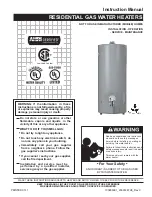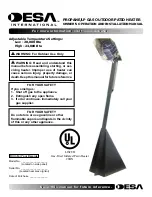
12
GAS SUPPLY SYSTEMS
Low pressure building gas supply systems are defined
as those systems that cannot under any circumstances
exceed 14” W.C. (1/2 PSI Gauge). These systems do
not require pressure regulation. Measurements should
be taken to insure that gas pressures are stable and fall
within the requirements stated on the water heater rating
plate. Readings should be taken with all gas burning
equipment off (static pressure) and with all gas burning
equipment running at maximum rate (dynamic pressure).
The gas supply pressure must be stable within 1.5”
W.C. from static to dynamic pressure to provide good
performance. Pressure drops that exceed 1.5” W.C.
may cause rough starting, noisy combustion or nuisance
outages. Increases or spikes in static pressure during
off cycles may cause failure to ignite or in severe cases
damage to appliance gas valves. If your low pressure
system does not meet these requirements, the installer is
responsible for the corrections.
High Pressure building supply systems use pressures
that exceed 14” W.C. (1/2 PSI Gauge). These systems
must use field supplied regulators to lower the gas
pressure to less than 14” W.C. (1/2 PSI Gauge).
Appliances require gas regulators that are properly
sized for the water heater input and deliver the rating
plate specified pressures. Gas supply systems where
pressure exceeds 5 PSI often require multiple regulators
to achieve desired pressures. Systems in excess of 5
PSI building pressure should be designed by gas delivery
professionals for best performance. Water heaters
connected to gas supply systems that exceed 14” W.C.
(1/2 PSI Gauge) at any time must be equipped with a gas
supply regulator.
GAS PRESSURE REQUIREMENTS
Natural gas models require a minimum gas supply
pressure of 5.0” W.C. (1.24 kPa). Propane gas models
require a minimum gas supply pressure of 11” W.C. (2.74
kPa). The minimum supply pressure is measured while
gas is flowing (dynamic pressure). The supply pressure
(dynamic) should never fall below the specified minimum
supply pressure. The supply pressure should be
measured with all gas fired appliances connected to the
common main firing at full capacity. If the supply pressure
drops more than 1.5” W.C. (0.37 kPa) as gas begins
to flow to the water heater then the supply gas system
including the gas line and/or the gas regulator may be
The gas valve on all models has a maximum gas supply
pressure limit of 14” W.C. (3.48 kPa) The maximum
supply pressure is measured while gas is not flowing
(static pressure).
SUPPLY GAS REGULATOR
The maximum allowable gas supply pressure for this
water heater is 14.0 inches W.C. (3.48 kPa). Install a
positive lock-up gas pressure regulator in the gas supply
line if inlet gas pressure can exceed 14.0 inches W.C.
(3.48 kPa) at any time. Regulators must be sized/used
according to manufacturer’s specifications.
If a positive lock-up regulator is required follow these
instructions:
1.
Positive lock-up gas pressure regulators must be rated
at or above the input Btu/hr rating of the water heater
they supply.
2.
Positive lock-up gas pressure regulator(s) should be
installed no closer than 3 feet (1 meter) and no farther
than 8 feet (2.4 meters) of equivalent length from the
water heater’s inlet gas connection.
3.
After installing the positive lock-up gas pressure
regulator(s), and while the water heater is operating,
an initial nominal supply pressure setting of 7.0” W.C.
is recommended and will generally provide good
water heater operation. Some addition adjustment
maybe required later to maintain a steady gas supply
pressure.
4.
When installing multiple water heaters in the same
gas supply system it is recommended that individual
positive lock-up gas pressure regulators be installed at
each unit.
INSTALLATION REQUIREMENTS
Summary of Contents for LTL07575
Page 37: ...37 NOTES ...
Page 38: ...38 ...













































